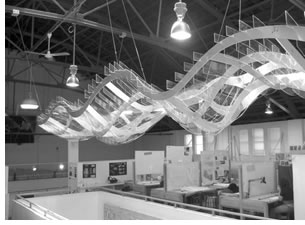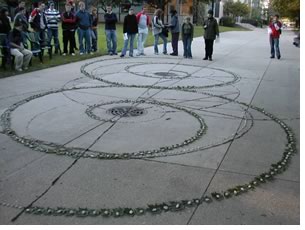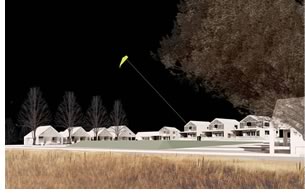

4/2006
Teaching faculty recognized for innovative courses

The AIA chose three programs to receive 2006 AIA Education Honor Awards for excellence in course development and architectural teaching. The awards program, now in its 17th year, recognizes collegiate faculty achievements and contributions to education and the discipline of architecture. The awards were announced March 31 during the ACSA Awards Ceremony at its annual meeting in Salt Lake City and will be presented in June during the AIA National Convention in Los Angeles.
The jury selected these three entries as exceptional models of instructional and educational excellence in classroom, studio, community-based service learning, or laboratory work. The jury looked for evidence of exceptional and innovative courses that:
- Deal with broad issues, particularly in cross-disciplinary collaboration and/or within the broader community
- Contribute to the advancement of architecture education
- Have the potential to benefit and/or change practice
- Promoted models of excellence that could be appropriated by other educators.
Throughout their deliberations, the jury noticed interesting trends among the group of submissions. “The three programs recognized this year are excellent examples of the outstanding work being done by students and faculty in our schools. Each award winner represents a standard for their respective subject that all schools should aspire to,” said Jury Chair David Hinson, AIA. “This is what the AIA Education Honor Award is all about: Recognizing excellence and helping us all to understand how this standard can be reached by educators across the country.”
The 2006 AIA Education Honors Award Winners
 “Digital Design-Build Initiative” by the School of Architecture
and Planning, Catholic University of America, Washington, D.C. The course
was developed by Luis Eduardo Boza, assistant professor; director, Summer
Institute for Architecture; and director, graduate concentration in digital
fabrication. This initiative is a collection of courses in which students
and future leaders in the design profession are asking questions about
the role of fabrication technologies in the design process and profession
as well as researching how these technologies can inform their own design
methodologies. Using the design-build model as a method for learning,
students are exposed to both traditional means and methods of construction
and the most innovative digital design and computer/numeric-controlled
fabrication technologies.
“Digital Design-Build Initiative” by the School of Architecture
and Planning, Catholic University of America, Washington, D.C. The course
was developed by Luis Eduardo Boza, assistant professor; director, Summer
Institute for Architecture; and director, graduate concentration in digital
fabrication. This initiative is a collection of courses in which students
and future leaders in the design profession are asking questions about
the role of fabrication technologies in the design process and profession
as well as researching how these technologies can inform their own design
methodologies. Using the design-build model as a method for learning,
students are exposed to both traditional means and methods of construction
and the most innovative digital design and computer/numeric-controlled
fabrication technologies.
“The course has gone beyond playing with digital technology as just a ‘smart’ tool and looks to how the technology begins to inform design directly,” the jury noted. “Students are learning about materiality through digital technology. They can explore the subject in a variety of ways. Thinking about a clear idea and its transformation into a well-crafted object is paramount, and the progression of three courses establishes a trajectory; it has a momentum that promises more advancement. Together, the three courses create an ensemble. This expands opportunities for a team of students with skills to go further integrating design ideas into built form.”
 “Architecture
I, II,” by the College of Architecture, Illinois
Institute of Technology, Chicago. The project’s development team
was Catherine Wetzel, assistant professor; Kathleen Nagle, lecturer;
and Paul Pettigrew, AIA, instructor. This two-semester studio sequence
has multiple objectives. At its most fundamental level, the sequence
of projects introduces the necessary two and three-dimensional technical
and compositional skills to prepare students for subsequent architectural
studies. More importantly, the focus on critical thinking, inquiry, and
hands-on investigation, both individual and collaborative, addresses
the larger conceptual and physical context of each assignment. The curriculum
also establishes a dialogue between the institution’s Modernist
legacy and contemporary architecture. The year begins with the investigation
of a common object and ends with a full-scale construction. The course
emphasizes the collaborative learning environment, which is modeled by
the teaching methodology and executed through individual and group projects.
“Architecture
I, II,” by the College of Architecture, Illinois
Institute of Technology, Chicago. The project’s development team
was Catherine Wetzel, assistant professor; Kathleen Nagle, lecturer;
and Paul Pettigrew, AIA, instructor. This two-semester studio sequence
has multiple objectives. At its most fundamental level, the sequence
of projects introduces the necessary two and three-dimensional technical
and compositional skills to prepare students for subsequent architectural
studies. More importantly, the focus on critical thinking, inquiry, and
hands-on investigation, both individual and collaborative, addresses
the larger conceptual and physical context of each assignment. The curriculum
also establishes a dialogue between the institution’s Modernist
legacy and contemporary architecture. The year begins with the investigation
of a common object and ends with a full-scale construction. The course
emphasizes the collaborative learning environment, which is modeled by
the teaching methodology and executed through individual and group projects.
“This program allows students to become immersed in many critical issues they have to think about as an architect, in a foundation course, including scale, materiality, landscape, and working collaboratively. First year design issues are addressed in a fresh, innovative way,” said the jury. “The professors transform the campus into a large laboratory. Students understand scale better through full-scale mockups rather than just drawing a human figure in their project. Relationships among plan, section, and axonometric are learned through presenting these drawings simultaneously.”
 “Habitat Trails: Habitat for Humanity: From Infill House to Green
Neighborhood,” by the University of Arkansas Community Design Center.
Fayetteville, Ark. The development team for this project included: Stephen
Luoni, Assoc. AIA, director, University of Arkansas Community Design
Center; Aaron Gabriel, Assoc. AIA, project director, University of Arkansas
Community Design Center; Jeffrey Huber, project designer, University
of Arkansas Community Design Center; and Marty Matlock, PhD, PE, associate
professor, University of Arkansas Department of Biological and Agricultural
Engineering.
“Habitat Trails: Habitat for Humanity: From Infill House to Green
Neighborhood,” by the University of Arkansas Community Design Center.
Fayetteville, Ark. The development team for this project included: Stephen
Luoni, Assoc. AIA, director, University of Arkansas Community Design
Center; Aaron Gabriel, Assoc. AIA, project director, University of Arkansas
Community Design Center; Jeffrey Huber, project designer, University
of Arkansas Community Design Center; and Marty Matlock, PhD, PE, associate
professor, University of Arkansas Department of Biological and Agricultural
Engineering.
The studio objective is to provide Habitat for Humanity with a model for eco-friendly, affordable development that offers high-value residential solutions to underserved populations and their surrounding communities. The challenge is to create place from Habitat’s modest single-family home specifications on a greenfield site. The studio is organized as a collaborative venture among architecture, landscape architecture, and ecological engineering departments. Architecture students were responsible for the production of the housing fabric and held accountable for integrating sustainable neighborhood technologies developed by the other departments. “This project has jumped the scale of the single-family house and provided a critical resource for the organization, and it gives back to its community,” the jury said. “Dollars that would have been spent on culverts and physical infrastructure can be used to create bioswales and more landscaped open space for the community.”
Copyright 2006 The American Institute of Architects.
All rights reserved. Home Page ![]()
![]()
2006
Education Honors Jury
• Chair David Hinson, AIA, associate professor and chair, Architecture
Program, School of Architecture, Auburn University,
• Matthew Fochs, vice president, American Institute of Architecture
Students
• Clark E. Llewellyn, AIA, director, Northwest and Pacific Region,
AIA
• Brigitte Shim, Assoc. AIA, Shim-Sutcliffe Architects Inc. and professor,
University of Toronto, Faculty of Architecture, Landscape, and Design,
Toronto
• Catherine Roussel, AIA, staff contact and director of education,
AIA.
National Convention program: The award-winning educators from Catholic University, the University of Arkansas, and Illinois Institute of Technology will present their work Friday, June 9, 1:30-3 p.m. in seminar “E38: 2006 AIA Education Honor Awards.” The session, moderated by Jury Chair David W. Hinson, AIA, offers 1.5 CES learning units, is free, but registration is required. See the AIA National Convention Web site for details and to register.
An exhibition of the work will be featured in the convention hall.
![]()